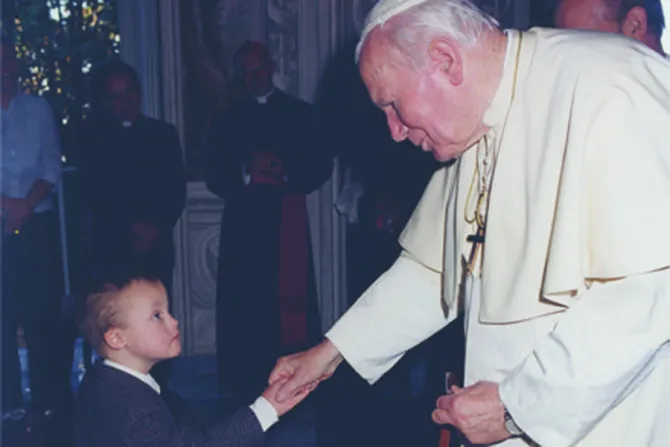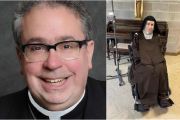Frank said it has been a "surreal" experience to have a child whose impact is so great that there are people asking for his prayers.
He said he hopes that people who read Brendan's story and are experiencing suffering themselves understand that they are never alone.
"Brendan never felt alone, and he knew that people were praying for him, starting with Pope John Paul II to the builders who were working on our house, to people he never knew," Frank said. Even people in other countries who had never met Brendan had offered their prayers.
A witness amid the 'culture of death'
Another suffering soul, Margaret Leo, also had a dad who worked in the Washington, D.C. political scene. Leonard Leo is the executive vice president of the Federalist Society - a law organization to which several federal and Supreme Court justices belong. He also worked for President George W. Bush's administration at one time.
Though Margaret suffered throughout her life from spina bifida and related complications, she bore everything with a cheerful smile and a simple but profound faith. Her photo now sits on the desk of U.S. Supreme Court Justice Clarence Thomas.
Ruse names the people impacted by these suffering souls in his book intentionally.
These were not peasant children, like Sts. Francisco and Jacinta Marto, Ruse noted, and that's important.
"They were born into influence and affluence, into a modern day (moral) desert, and they have a message for the modern day desert - all lives are worth living, there are no useless lives, even short, painful lives have a great deal of meaning," Ruse said.
"We live in an age that people call the culture of death, aimed largely at the defenseless: children, the elderly, the disabled, the intellectually disabled, and these children are witnesses to the fact that all lives are worth living, even ones that are judged not to be worth living."

It's something that Margaret's mom, Sally, hopes that people understand as they read her daughter's story.
"Especially because such a high percentage of children with spina bifida and other disabilities are aborted these days, and we barely even ever see them," she told CNA.
"If that wasn't the case, we would see these kids walking around, we would see kids with braces or crutches or Down syndrome all the time, but 80-90 percent of them are killed, they're not even given the chance."
But in Sally's experience, "It was a gift."
Margaret taught them about faith and love in the simplest of ways. She gently pestered her dad until he became a daily Mass attendee. She would ask people when they were going to baptize their new baby, or if they had been confirmed.
"Her faith would invariably come up in any discussion that was more the perfunctory, and it would have an impact on people," her father, Leonard, told CNA.
But she wasn't a mystic, her parents insist. She just had a strong attraction to holy and beautiful things, and an intense but simple joy that was attractive to those around her. She loved coloring, and being involved in her siblings' antics, and holding babies.
"In other words, you wouldn't necessarily go away thinking, 'Oh wow, I just met a saint.' But she would say to you, 'Hi, how are you? How was your day? How was your birthday? When's your confirmation?' She wanted to know about you, which was really what touched people most about her, because you don't necessarily find that among strangers," Sally said.
"Charity and kindness and friendship, but at its most pure and most intense level," Leonard added.
Margaret's spina bifida meant that she had to have titanium rods placed in her back to straighten her spine. But instead, Margaret's back bent the titanium rods - so much so that they ended up protruding from her neck. Despite it all, Margaret did not complain.
"It's ok," she would cheerfully say, even when it was clear that it was not.
Today, Leonard keeps the rods on his desk - "to remind me what a real bad day looks like."
After Margaret passed away and her story spread, the Leos were surprised at the impact their simple but faithful little girl was having on the people around them. When Ruse published an article about Margaret, they received hundreds of requests for a prayer card of her.
What continues to draw people to Margaret is how she suffered with joy and trust in God, Leonard said.
"I think at some level that when we're faced with adversity and suffering, we wish that we could be filled with joy, and we could be able to confront it in a way that brings us closer to God and closer to other people, and make the very best of it," he said.
"And so when you saw her, it was impossible not to be reminded of the fact that we should be filled with joy, we should be thankful to God. As her tombstone says, we should be praying and thanking God without ceasing."
Tears of inspiration
The third contemporary little suffering soul whose story Ruse tells is that of Audrey from France.
Although her parents were lukewarm Catholics when she was born, Audrey was "spiritually precocious" from a young age.
She practiced mortification by carrying home her school pencils in her shoe. She begged to receive Holy Communion at the age of five. Upon examining her, her priest found her ready to do so, because she understood that Holy Communion is Jesus, "And I want to receive Jesus." She insisted that her family say grace before meals and a prayer for vocations every night.
She was also sure from a young age that she had a Carmelite vocation, "Caramel" as the little girl pronounced it.
This surprising faith scared Lillian, Audrey's mom, who wasn't sure where Audrey was getting her ideas.
"Follow her," a priest told Lillian.
But she was also scared that her daughter's spiritual maturity meant great trials were ahead - and they were. At a very young age, Audrey was diagnosed with leukemia.

When Lillian broke the news to Audrey, "She got this very wise, very gentle sort of look" and told her mother that they were "going to do what Jesus says. We're going to be like the birds in the sky, and we're just going to take one day at a time."
"I can't say that without weeping," Ruse said.
And indeed, "Littlest Suffering Souls" is a book that will make you weep. But not in a sad way.
"We're not crying out of sadness, we're crying out of inspiration," Ruse said.
"They're neither tears of joy nor sadness, they're some other kind of tear, that I don't have the name for, but it's just being moved by these inspiring stories."
Audrey battled leukemia for several years, and, like Brendan, made it on the personal prayer list of Pope John Paul II after her dad was able to hand him a photo of her.
Audrey too offered her sufferings for specific intentions, and, like Brendan, people began flooding her with prayer requests. She had a special heart for vocations, and prayed especially for her Uncle Mick - who is now a priest today.
A bone marrow transplant for Audrey eventually proved ineffective. Knowing she was near death, her family took her to Lourdes, and then to Rome, where she was able to meet Pope John Paul II.
They spoke together for several minutes, captured by a photo of Audrey's swollen head next to the bent-down head of the now-Saint.
While no one knows what was said between the two of them, for the rest of the day, John Paul II could be heard around the Vatican muttering her name: "Audrey, Audrey, Audrey."
She also asked to be confirmed, and insisted that the party be an "elegant" event - one of her favorite words, but one that she meant in beautiful simplicity, rather than extravagance.
In her final weeks, which she was able to spend at home, Audrey spent hours in the family's chapel, where the bishop had allowed them to keep the blessed sacrament. She told her grandma that she spent her days praying and waiting.
She passed away at 3 p.m., the hour of mercy, on August 22, 1991, the Feast of the Queenship of Mary. Her father Jerome had prayed she would pass away on a Marian feast day.
Audrey's cause for canonization has been opened, and her story has spread throughout France and indeed throughout the world. Seminarians pray for her intercession for their vocations. A Carmelite convent in Spain has her First Communion dress on display, with permission of the family.
Lessons learned
The suffering of children is a difficult subject, but one that captures the attention of all, Ruse said.
"It seems to us to be profoundly unfair that children suffer, and that's a common human reaction," he reflected.
"Moreover, the reaction of these particular children to their suffering and maladies is confounding to those of us who cannot even handle the simple contradictions of the day very well," he said.
"The simplest things can vex us, and yet these are kids who had bone marrow transplants and while they had them, Audrey was singing songs to Mary, and Brendan was offering his suffering for others - they're just astounding."
At the end of his book, Ruse offers what he believes are several lessons that can be learned from the stories of little suffering souls - forbearance, simplicity, a love for God, particularly in the Eucharist.
Moreover, he said, we learn that each life has dignity.
"Our modern man might see a child suffering from leukemia who has died young and see nothing but a misbegotten tragedy, a life with no meaning," he wrote.
"In the simplest terms, modern man is wrong. The Littlest Suffering Souls stand as witnesses to the proposition that all human life has meaning and dignity, even and especially those lives we may not fully understand."
This article was first published May 17, 2017. It has been updated accordingly.
Mary Farrow worked as a staff writer for Catholic News Agency until 2020. She has a degree in journalism and English education from the University of Nebraska-Lincoln.




